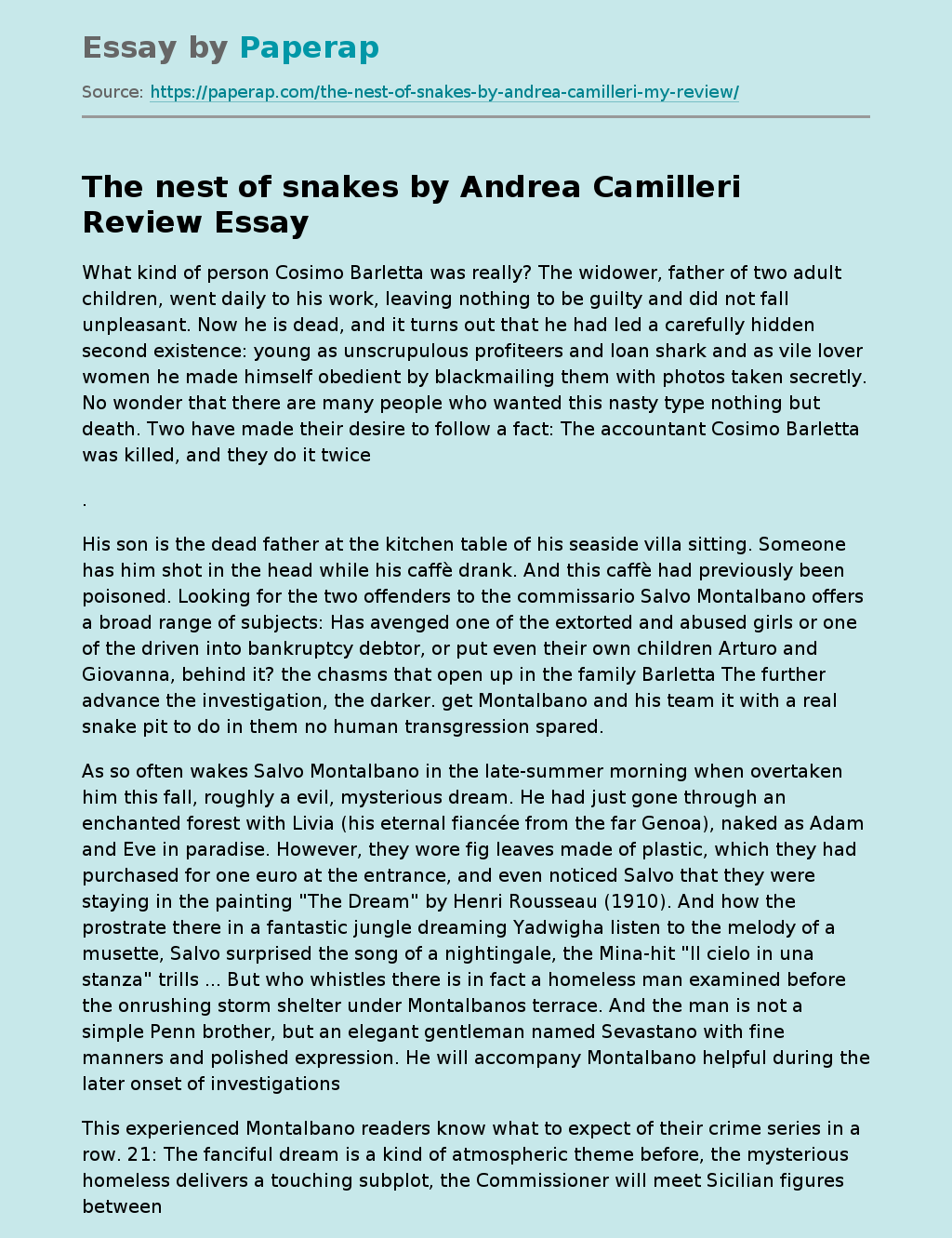The Nest Of Snakes By Andrea Camilleri Review
What kind of person Cosimo Barletta was really? The widower, father of two adult children, went daily to his work, leaving nothing to be guilty and did not fall unpleasant. Now he is dead, and it turns out that he had led a carefully hidden second existence: young as unscrupulous profiteers and loan shark and as vile lover women he made himself obedient by blackmailing them with photos taken secretly. No wonder that there are many people who wanted this nasty type nothing but death.
Two have made their desire to follow a fact: The accountant Cosimo Barletta was killed, and they do it twice.
His son is the dead father at the kitchen table of his seaside villa sitting. Someone has him shot in the head while his caffè drank. And this caffè had previously been poisoned. Looking for the two offenders to the commissario Salvo Montalbano offers a broad range of subjects: Has avenged one of the extorted and abused girls or one of the driven into bankruptcy debtor, or put even their own children Arturo and Giovanna, behind it? the chasms that open up in the family Barletta The further advance the investigation, the darker get Montalbano and his team it with a real snake pit to do in them no human transgression spared.
As so often wakes Salvo Montalbano in the late-summer morning when overtaken him this fall, roughly a evil, mysterious dream. He had just gone through an enchanted forest with Livia (his eternal fiancée from the far Genoa), naked as Adam and Eve in paradise.
However, they wore fig leaves made of plastic, which they had purchased for one euro at the entrance, and even noticed Salvo that they were staying in the painting “The Dream” by Henri Rousseau (1910). And how the prostrate there in a fantastic jungle dreaming Yadwigha listen to the melody of a musette, Salvo surprised the song of a nightingale, the Mina-hit “Il cielo in una stanza” trills… But who whistles there is in fact a homeless man examined before the onrushing storm shelter under Montalbanos terrace. And the man is not a simple Penn brother, but an elegant gentleman named Sevastano with fine manners and polished expression. He will accompany Montalbano helpful during the later onset of investigations.
This experienced Montalbano readers know what to expect of their crime series in a row: The fanciful dream is a kind of atmospheric theme before, the mysterious homeless delivers a touching subplot, the Commissioner will meet Sicilian figures between lovable codgers and common cons Lingen in his interrogations on a spectrum, he encounters ever new surprises the monster Barletta secret life, and with razor sharp conclusions and intuition he comes to the truth on the track. For the extra work in detail the able inspector Fazio is always ready (without his boss his anticipatory friendly care to appreciate know), Substitute Mimì Augello is used for special tasks, and Catarella has not yet learned it even after years, the simplest of news unmutilated to his boss pass on. Oh, Livia also looks again over (not only in the dream) and complicated Salvos everyday. The love finds Salvo not only in the throes of his eternal distance relationship. And even more when they so busy brooding his loneliness.
Nothing really new in Vigata? Can it even something surprising coming from the Sicilian over ninety-year institution that has shaped their island home in Germany and abroad in almost countless novels image and even the language like no other author? (His Montalbano series has caused a popularity that other books for width and depth.) Camilleri uses, in fact, from a modular system of discharges, characters and plot ideas; his repertoire of scenes and dialogues is not infinite. So undoubtedly the knitting pattern of vicious war of words repeated with the coroner dottor Pasquano from jealousies with colleagues from misunderstandings with Livia, from still cramming the superior Questore. But all this is known as our home. As we are at every homecoming curious how Salvo is this time on it, and look forward to the fine variations of the familiar that every time are spiced up with imagination, wit and cultured allusions to works of literature, film, music and (translator: Rita Seuss and Walter Kögler) painting and then “the nest of snakes” ends, thriller and psychological novel at the same time, very different from what was initially expected: tragic pity exciting and full of melancholy. In the epilogue (which you should read only after the novel, if you want to get the full voltage on the output) we learn incidentally that the book before its release five years drawer was (to make a change).
The Nest Of Snakes By Andrea Camilleri Review. (2019, Nov 18). Retrieved from https://paperap.com/the-nest-of-snakes-by-andrea-camilleri-my-review/

